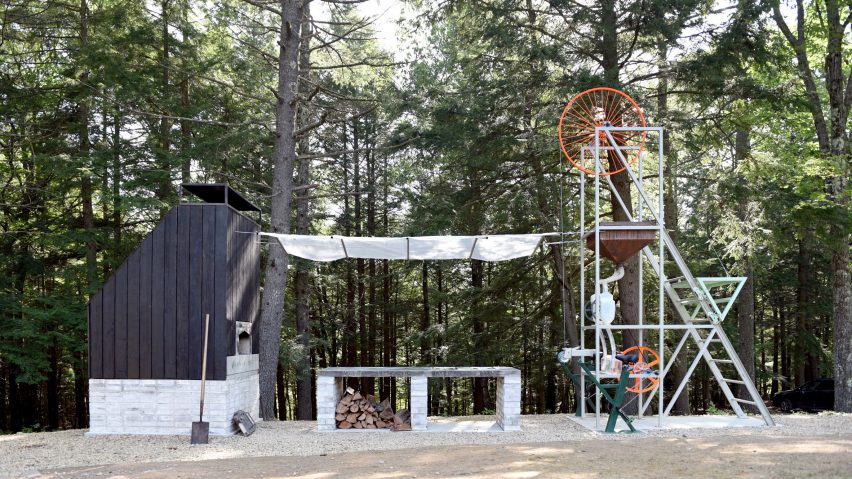London-based practice Studio Micat has built an outdoor bakery in a forest in New England, which uses a bicycle to grind up flour for making loaves of sourdough.
Studio Micat designers Michael Garnett and Cathrin Walczyk developed a "human-powered bakery" for the Beam Camp children's camp, located in Stratford, New Hampshire.
Comprising an apparatus for grinding flour and an oven, the Brawn & Bread structure is designed to highlight how distanced people have become from the physical effort required to make food.
Rather than using sources of power like electricity, it only functions on human exertion.
"The bread gym is a small but salutary reminder of the effort required to produce this daily essential, and will hopefully inspire a more respectful attitude towards the humble loaf," said Studio Micat in a project description.
"It relinks effort and reward, requiring a whole body workout of its users and in so doing provides the sustenance to refuel afterwards."
Flour is ground in the metallic contraption at one end of the structure, with the process beginning by hauling grain sacks to the top via a cable winch.
From here, the sacks are emptied by hand into two hoppers. The grain is then sent by the funnel-shaped devices into a mill, where it is ground into flour using the power provided when users pedal on a stationary bike below.
The flour is then collected and added into glass jars, to be used as a sourdough starter for bread.
Eighty campers aged between 11 and 17 built the structure with Studio Micato during camp in August 2018, and then learned how to function the machine. The apparatus can provide bread for up to 150 campers and staff members every day.
As part of the project, the architects and designers also taught the kids construction techniques, such as casting concrete, welding metal and using power tools.
These efforts also included laying bricks to form a central island, where the children use muscle to knead the bread, shape it and leave it to prove. These actions are inscribed on the edge of the counter as "mill it, knead it, bake it", and finished with "earn it" to signal consumption.
A white material stretches above the counter and meets the top of the bread oven. Timber planks that the children have charred black using the Japanese technique of shou sugi ban, which offers protection from weathering, cover the firepit structure.
The charred cladding around the oven informs the simple, muted tones of Brawn & Bread overall. The project's natural palette is only countered by three bright orange wheels.
"The pared-back palette of materials reflects the simplicity of ingredients used in bread – flour, water and salt," said the studio.
Architects and designers are often experimenting with food production, in response to shortages in poorer countries and vast amounts of waste in wealthier areas.
Other examples include edible food packaging, 3D-printed snacks made from food waste and a steak grown in a lab.
Photography is by Studio Micat.

